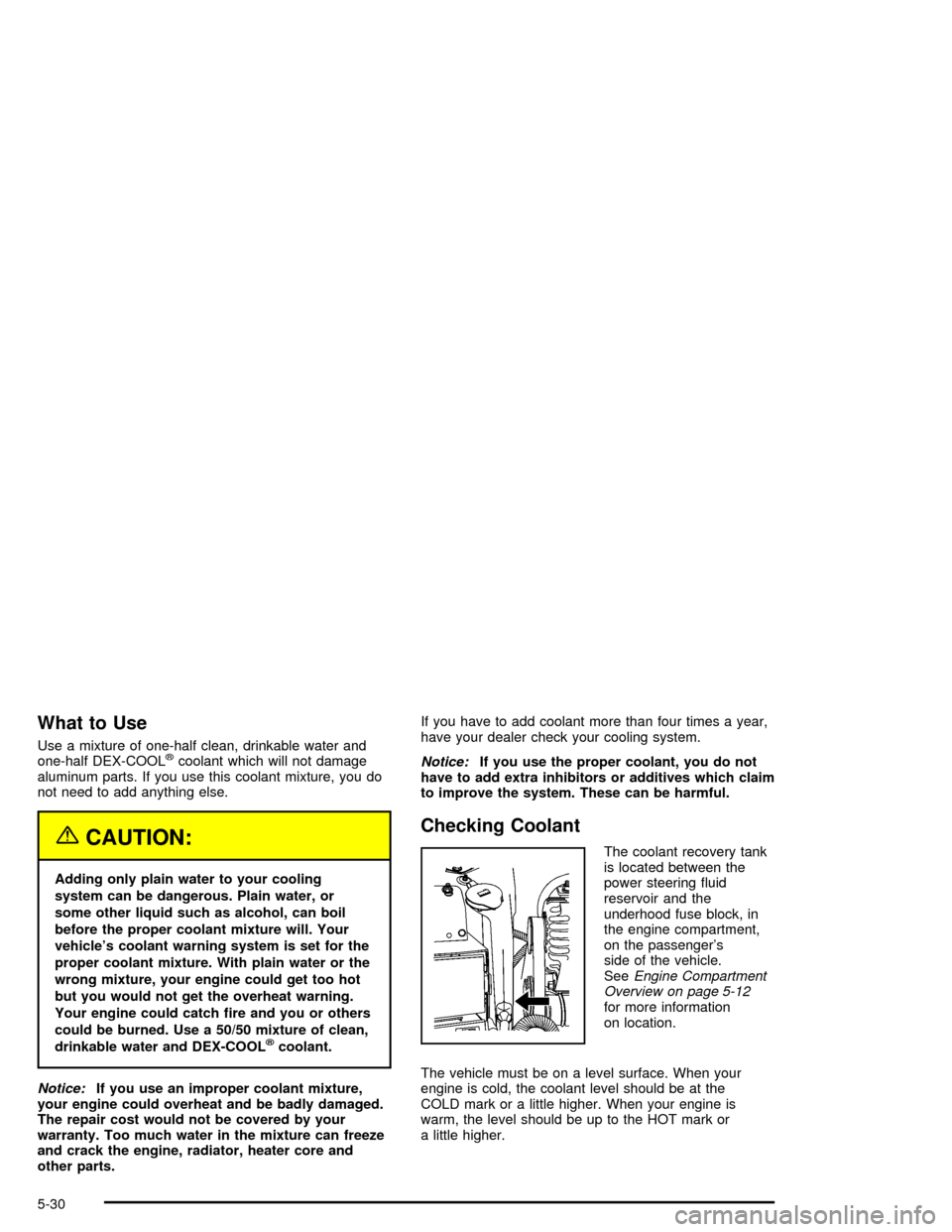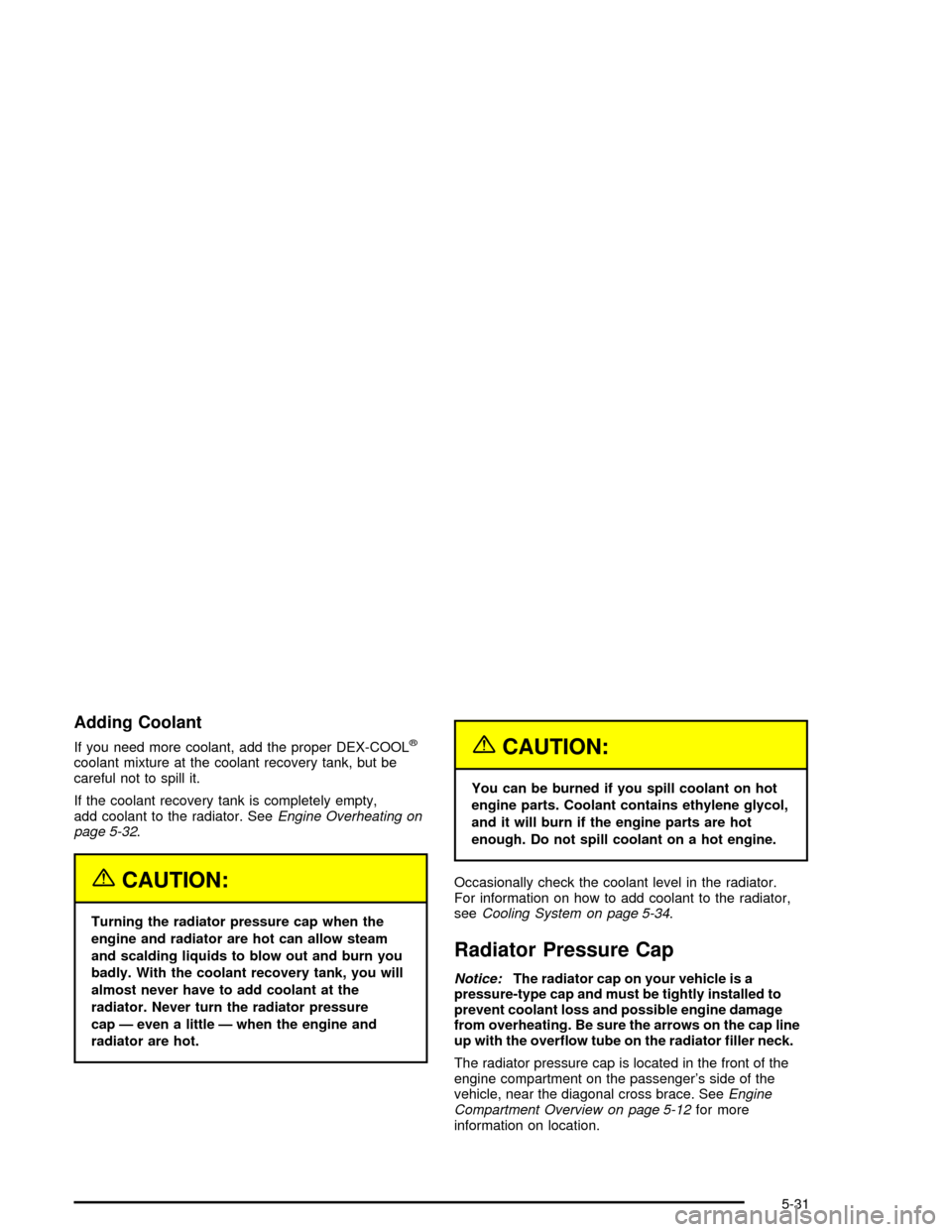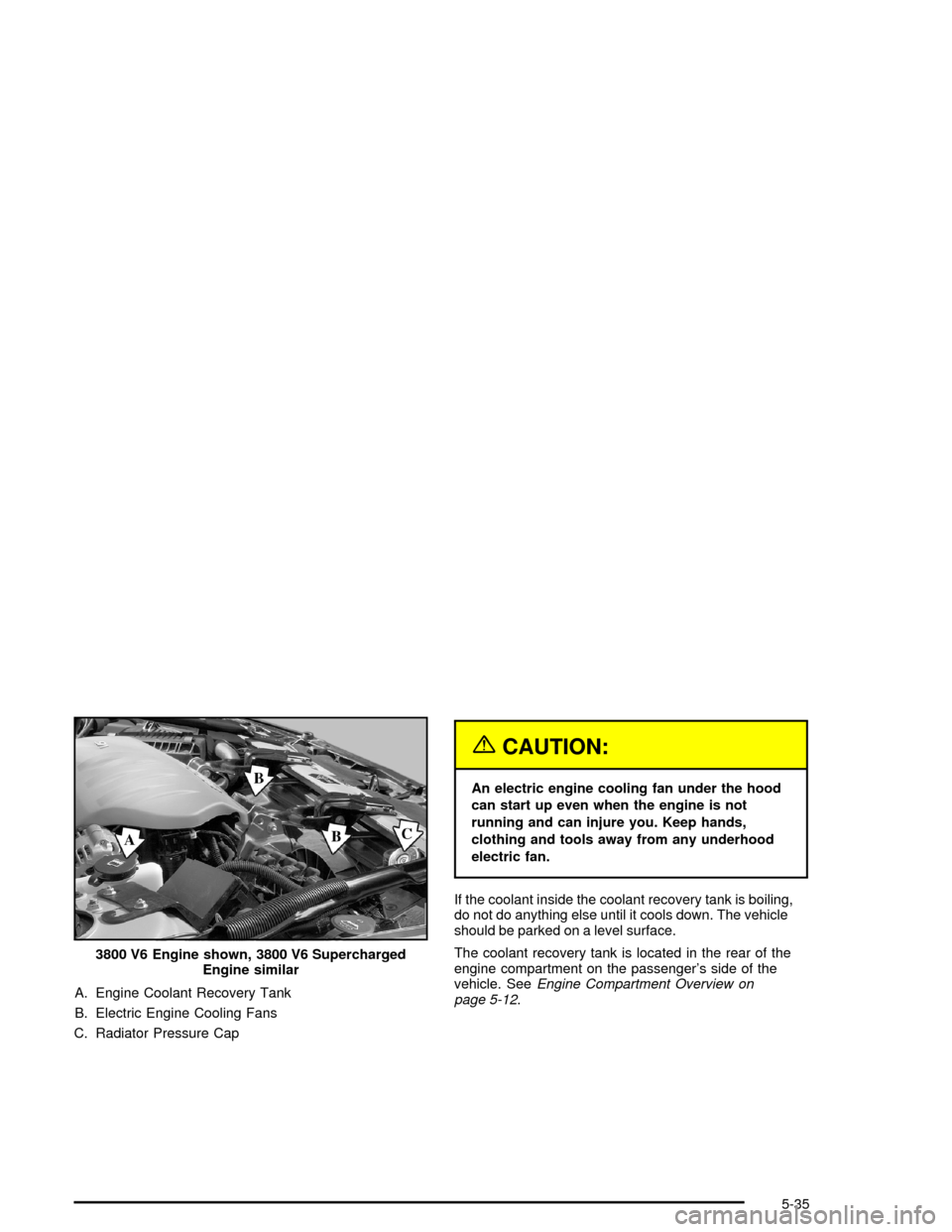2005 CHEVROLET IMPALA coolant level
[x] Cancel search: coolant levelPage 114 of 398

Message Center.............................................3-40
Service Traction System Warning Message......3-40
Traction Active Message................................3-41
Battery Warning Message..............................3-41
Hot Coolant Temperature Warning Message.....3-42
Low Oil Pressure Message............................3-42
Low Engine Oil Level Message.......................3-43
Change Engine Oil Message..........................3-44
Low Tire Message........................................3-44
Door Ajar Warning Message...........................3-45
Trunk Ajar Warning Message.........................3-45
Security Message.........................................3-46
Low Washer Fluid Warning Message...............3-46
Low Fuel Warning Message...........................3-47
Low Brake Fluid Warning Message.................3-47
Service Vehicle Soon Message.......................3-48
Highbeam Out Warning Message....................3-48Driver Information Center (DIC).......................3-49
Trip Computer................................................3-51
Audio System(s).............................................3-52
Setting the Time...........................................3-52
Radio with Cassette......................................3-53
Radio with CD..............................................3-64
Radio with Cassette and CD..........................3-74
Theft-Deterrent Feature..................................3-87
Audio Steering Wheel Controls.......................3-87
Radio Reception...........................................3-88
Care of the Cassette Tape Player...................3-88
Care of Your CDs.........................................3-90
Care of the CD Player...................................3-90
Backglass Antenna.......................................3-90
XM™ Satellite Radio Antenna System.............3-91
Vehicle Customization Settings.......................3-91
Chime Level Adjustment................................3-91
Section 3 Instrument Panel
3-2
Page 154 of 398

Hot Coolant Temperature Warning
Message
This message is displayed when the cooling system
temperature gets hot. A chime will sound
continuously, also.
Check the coolant temperature gage and the coolant
level. SeeEngine Coolant on page 5-29,Engine Coolant
Temperature Gage on page 3-34andEngine
Overheating on page 5-32for further information.
Low Oil Pressure Message
This message is displayed in the message center when
the engine oil pressure is low. A chime will sound
continuously, also.
If this occurs, you should have your vehicle serviced
immediately. United StatesCanada
United StatesCanada
3-42
Page 261 of 398

A. Windshield Washer Fluid Reservoir. See “Adding
Washer Fluid” underWindshield Washer Fluid
on page 5-44.
B. Battery. SeeBattery on page 5-48.
C. Remote Positive (+) Terminal. SeeJump Starting on
page 5-49.
D. Upper Underhood Fuse Block. See “Underhood
Fuse Block (Upper)” underUnderhood Fuse Block
on page 5-103.
E. Lower Underhood Fuse Block. See “Underhood
Fuse Block (Lower)” underUnderhood Fuse Block
on page 5-103.
F. Engine Coolant Recovery Tank. See “Checking
Coolant” underCooling System on page 5-34.
G. Radiator Pressure Cap. SeeRadiator Pressure Cap
on page 5-31.
H. Power Steering Fluid Reservoir. SeePower Steering
Fluid on page 5-43.I. Engine Coolant Air Bleed Valves (underneath engine
shield). See “How to Add Coolant to the Radiator”
underCooling System on page 5-34.
J. Electric Cooling Fan. SeeCooling System on
page 5-34.
K. Engine Oil Fill Cap. See “When to Add Engine Oil”
underEngine Oil on page 5-18.
L. Engine Oil Dipstick. See “Checking Engine Oil”
underEngine Oil on page 5-18.
M. Automatic Transaxle Fluid Dipstick. See “Checking
the Fluid Level” underAutomatic Transaxle Fluid
on page 5-26.
N. Brake Master Cylinder Reservoir. See “Brake Fluid”
underBrakes on page 5-45.
O. Engine Air Cleaner/Filter. SeeEngine Air
Cleaner/Filter on page 5-25.
5-13
Page 263 of 398

A. Windshield Washer Fluid Reservoir. See “Adding
Washer Fluid” underWindshield Washer Fluid
on page 5-44.
B. Battery. SeeBattery on page 5-48.
C. Remote Positive (+) Terminal. SeeJump Starting on
page 5-49.
D. Upper Underhood Fuse Block. See “Underhood
Fuse Block (Upper)” underUnderhood Fuse Block
on page 5-103.
E. Lower Underhood Fuse Block. See “Underhood
Fuse Block (Lower)” underUnderhood Fuse Block
on page 5-103.
F. Engine Coolant Recovery Tank. See “Checking
Coolant” underCooling System on page 5-34.
G. Radiator Pressure Cap. SeeRadiator Pressure Cap
on page 5-31.
H. Electric Cooling Fan. SeeCooling System on
page 5-34.I. Power Steering Fluid Reservoir (low in engine
compartment). SeePower Steering Fluid on
page 5-43.
J. Engine Oil Dipstick. See “Checking Engine Oil”
underEngine Oil on page 5-18.
K. Engine Oil Fill Cap. See “When to Add Engine Oil”
underEngine Oil on page 5-18.
L. Engine Coolant Air Bleed Valves (underneath engine
shield). See “How to Add Coolant to the Radiator”
underCooling System on page 5-34.
M. Automatic Transaxle Fluid Dipstick. See “Checking
the Fluid Level” underAutomatic Transaxle Fluid
on page 5-26.
N. Brake Master Cylinder Reservoir. See “Brake Fluid”
underBrakes on page 5-45.
O. Engine Air Cleaner/Filter. SeeEngine Air
Cleaner/Filter on page 5-25.
5-15
Page 265 of 398

A. Windshield Washer Fluid Reservoir. See “Adding
Washer Fluid” underWindshield Washer Fluid
on page 5-44.
B. Battery. SeeBattery on page 5-48.
C. Radiator Pressure Cap. SeeRadiator Pressure Cap
on page 5-31.
D. Underhood Fuse Block. SeeUnderhood Fuse Block
on page 5-103.
E. Remote Positive (+) Terminal. SeeBattery on
page 5-48.
F. Engine Coolant Recovery Tank. See “Checking
Coolant” underCooling System on page 5-34.
G. Electric Cooling Fan. SeeCooling System on
page 5-34.H. Power Steering Fluid Reservoir (below generator).
SeePower Steering Fluid on page 5-43.
I. Engine Oil Dipstick. See “Checking Engine Oil”
underEngine Oil on page 5-18.
J. Engine Oil Fill Cap. See “When to Add Engine Oil”
underEngine Oil on page 5-18.
K. Automatic Transaxle Fluid Dipstick. See “Checking
the Fluid Level” underAutomatic Transaxle Fluid
on page 5-26.
L. Brake Fluid Reservoir. See “Brake Fluid” under
Brakes on page 5-45.
M. Engine Air Cleaner/Filter. SeeEngine Air
Cleaner/Filter on page 5-25.
5-17
Page 278 of 398

What to Use
Use a mixture of one-half clean, drinkable water and
one-half DEX-COOL®coolant which will not damage
aluminum parts. If you use this coolant mixture, you do
not need to add anything else.
{CAUTION:
Adding only plain water to your cooling
system can be dangerous. Plain water, or
some other liquid such as alcohol, can boil
before the proper coolant mixture will. Your
vehicle’s coolant warning system is set for the
proper coolant mixture. With plain water or the
wrong mixture, your engine could get too hot
but you would not get the overheat warning.
Your engine could catch �re and you or others
could be burned. Use a 50/50 mixture of clean,
drinkable water and DEX-COOL
®coolant.
Notice:If you use an improper coolant mixture,
your engine could overheat and be badly damaged.
The repair cost would not be covered by your
warranty. Too much water in the mixture can freeze
and crack the engine, radiator, heater core and
other parts.If you have to add coolant more than four times a year,
have your dealer check your cooling system.
Notice:If you use the proper coolant, you do not
have to add extra inhibitors or additives which claim
to improve the system. These can be harmful.
Checking Coolant
The coolant recovery tank
is located between the
power steering �uid
reservoir and the
underhood fuse block, in
the engine compartment,
on the passenger’s
side of the vehicle.
SeeEngine Compartment
Overview on page 5-12
for more information
on location.
The vehicle must be on a level surface. When your
engine is cold, the coolant level should be at the
COLD mark or a little higher. When your engine is
warm, the level should be up to the HOT mark or
a little higher.
5-30
Page 279 of 398

Adding Coolant
If you need more coolant, add the proper DEX-COOL®
coolant mixture at the coolant recovery tank, but be
careful not to spill it.
If the coolant recovery tank is completely empty,
add coolant to the radiator. SeeEngine Overheating on
page 5-32.
{CAUTION:
Turning the radiator pressure cap when the
engine and radiator are hot can allow steam
and scalding liquids to blow out and burn you
badly. With the coolant recovery tank, you will
almost never have to add coolant at the
radiator. Never turn the radiator pressure
cap — even a little — when the engine and
radiator are hot.
{CAUTION:
You can be burned if you spill coolant on hot
engine parts. Coolant contains ethylene glycol,
and it will burn if the engine parts are hot
enough. Do not spill coolant on a hot engine.
Occasionally check the coolant level in the radiator.
For information on how to add coolant to the radiator,
seeCooling System on page 5-34.
Radiator Pressure Cap
Notice:The radiator cap on your vehicle is a
pressure-type cap and must be tightly installed to
prevent coolant loss and possible engine damage
from overheating. Be sure the arrows on the cap line
up with the over�ow tube on the radiator �ller neck.
The radiator pressure cap is located in the front of the
engine compartment on the passenger’s side of the
vehicle, near the diagonal cross brace. SeeEngine
Compartment Overview on page 5-12for more
information on location.
5-31
Page 283 of 398

A. Engine Coolant Recovery Tank
B. Electric Engine Cooling Fans
C. Radiator Pressure Cap
{CAUTION:
An electric engine cooling fan under the hood
can start up even when the engine is not
running and can injure you. Keep hands,
clothing and tools away from any underhood
electric fan.
If the coolant inside the coolant recovery tank is boiling,
do not do anything else until it cools down. The vehicle
should be parked on a level surface.
The coolant recovery tank is located in the rear of the
engine compartment on the passenger’s side of the
vehicle. SeeEngine Compartment Overview on
page 5-12. 3800 V6 Engine shown, 3800 V6 Supercharged
Engine similar
5-35